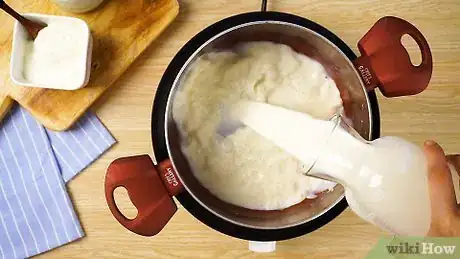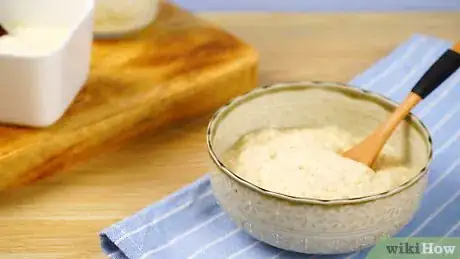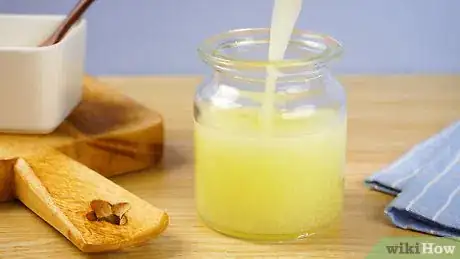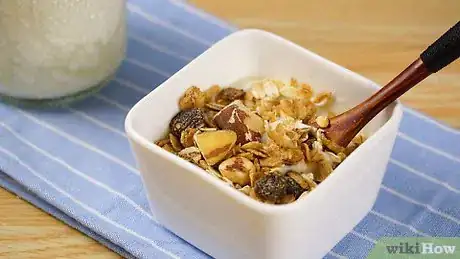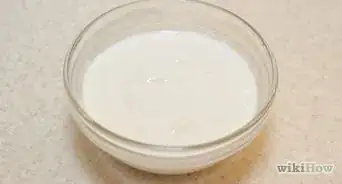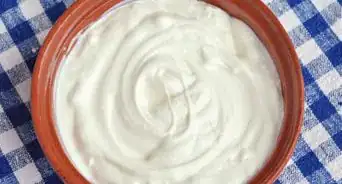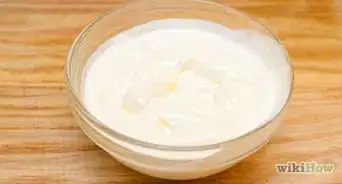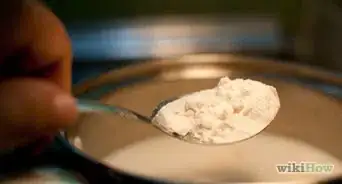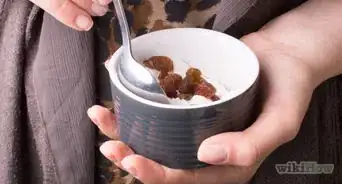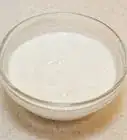This article was co-authored by wikiHow Staff. Our trained team of editors and researchers validate articles for accuracy and comprehensiveness. wikiHow's Content Management Team carefully monitors the work from our editorial staff to ensure that each article is backed by trusted research and meets our high quality standards.
The wikiHow Culinary Team also followed the article's instructions and verified that they work.
This article has been viewed 253,712 times.
Learn more...
Greek yogurt is a thick, creamy and extremely flavorful variety of the traditional milk product. The only difference between "normal" yogurt and Greek yogurt is that the whey has been removed in the Greek variety, concentrating its flavor. Luckily, homemade Greek yogurt is quite simple to make and almost impossible to mess up. Give it a try!
Steps
Making Greek Yogurt From Scratch
-
1Prepare the milk. Pour 1 liter (¼ gallon) of milk into a clean saucepan and let it heat until it's just nearly scalding. When it reaches a temperature of about 176° F (80° C), remove it from the burner.
-
2Let the milk cool down. You can use an ice-bath if you like, or simply let it cool on its own. When the milk cools down to a temperature of 108° to 115° F (42° to 46° C), transfer it into a glass or earthenware bowl. Do not use stainless steel. Allow to cool down until it's just warm.
- Why shouldn't you use stainless steel as a receptacle for the milk? Yogurt is made using bacteria cultures, which need very specific environments to survive and breed in. Using metal (stainless steel) can interfere with the bacteria culture.
Advertisement -
3Add the yogurt or culture packets. First check that the milk has cooled to the right temperature. Feel the side of the bowl with your hands. If it has cooled down enough, whisk in 3 tablespoons of live yogurt or one yogurt starter package until completely incorporated.
- If you incorporate plain yogurt into your milk, make sure the yogurt you use contains a live culture. Check the label on the yogurt packet to make sure that "live culture" is written on there somewhere. (Some commercial yogurt products don't contain a live culture.)
- If using a yogurt starter packet (which contains the necessary bacteria culture), follow the manufacturer's directions about which proportions to use.
-
4Keep the yogurt warm for approximately 4 to 12 hours. Cover your not-yet-yogurt with a clean towel, turn on the oven to its warm setting, and let rest for at least 4 hours but preferably overnight. If you can, try to set the oven's temperature so that it stays at a steady 108° F for the entire time.[1]
- Why does the bacteria need heat to make yogurt out of milk? 108° F is approximately the temperature at which the yogurt cultures begin consuming the lactose in the milk. This process is called fermentation, and it's the same process that produces beer from wheat or wine from grapes.
-
5Strain the yogurt. The next morning, the yogurt should look like a white firm custard. Next, place the cheesecloth or muslin cloth into the sieve, with a glass bowl placed underneath. Ladle the yogurt into the cloth and allow it to strain, until it achieves your desired consistency.
- As the draining process will take several hours, it's best to transfer it into the fridge. This process gets rid of all the excess water and makes your yoghurt thicker and much creamier.
- If you don't have muslin cloth or cheesecloth to strain the whey from the yogurt, use an old t-shirt that you aren't particularly tied to.
-
6Serve. When your yogurt has reached the consistency that you wish, it is ready to eat. It can be enjoyed plain, with nuts or honey, fruit, or even be used for the base for sauces like tzatziki. Enjoy!
Other Considerations
-
1Make use of the whey. Instead of discarding the whey that becomes a by-product of Greek yogurt, find a use for it instead. If you're really intrepid, you can drink it straight up, although it may not taste very appetizing. Here are some ideas you can tweak to make use of your leftover whey:
- Freeze it up in an ice cube tray and add it to your smoothies for added nutritional content.[2] If you don't want to hassle with freezing it, you can just add it as-is to your smoothie.
- Replace buttermilk, milk, or water with whey in your baking. Have a recipe that requires one of those three? Why not try whey instead? Use whey to bake bread or even pancakes.
-
2Pay your bacteria forward. Once you make your own yogurt, you can use the bacteria cultures present in it to serve as the starter for your next batch of yogurt. The third or fourth generation starter, however, might not be as tasty as a first generation starter, so be sure to invest in some new bacteria after the third or fourth batch of yogurt.
-
3Use your yogurt in dozens of delicious recipes. Yogurt is fantastic on its own, especially if it's homemade. You can also use yogurt in a number of great-tasting recipes if you accidentally make a too-big batch and don't know what to do with it. Here are some ideas for you to ponder:
- Make a tropical yogurt parfait
- Make frozen yogurt cups
- Make a sweet lassi
- Make blueberry yogurt cookies
Community Q&A
-
QuestionCan I add flavors while setting the yogurt?
 Community AnswerCommon practice is to add any flavoring after the yogurt has been strained of excess whey.
Community AnswerCommon practice is to add any flavoring after the yogurt has been strained of excess whey. -
QuestionI want to make high protein yogurt, how do I do that by using a high protein starter?
 Community AnswerAdd skim milk powder in milk before boiling the milk. By adding dry milk powder, you are increasing the protein content. For example, 8 oz. milk gives 8 grams protein. When you add dry milk powder, enough to make 8 oz. milk, you are doubling the protein content.
Community AnswerAdd skim milk powder in milk before boiling the milk. By adding dry milk powder, you are increasing the protein content. For example, 8 oz. milk gives 8 grams protein. When you add dry milk powder, enough to make 8 oz. milk, you are doubling the protein content. -
QuestionIs Greek yogurt healthy or not?
 Community AnswerYes! Greek yogurt in incredibly healthy for you. It is full of protein, calcium, and probiotics. It can also help you lose weight, as long as you eat it in moderation and exercise regularly.
Community AnswerYes! Greek yogurt in incredibly healthy for you. It is full of protein, calcium, and probiotics. It can also help you lose weight, as long as you eat it in moderation and exercise regularly.
Things You'll Need
- 1 saucepan
- 2 bowls
- 1 spoon
- 1 sieve
- 1 cheesecloth, or thin napkin
- 1 ladle
- 1 tea towel
About This Article
To make Greek yogurt, first heat 1 quart (950 mL) of pasteurized milk over medium-low heat. Stick a food thermometer into the milk every 3-5 minutes to monitor the temperature. Once the milk is heated to 160 °F (71 °C), turn the heat off and wait for the temperature to drop to 110 °F (43 °C). Then, add 1 packet of yogurt starter. If you’d prefer, you can also use 3 tablespoons (46 g) of live yogurt. Stir the milk and yogurt together for 1 minute. Next, pour the mixture into a glass container and put on an airtight, oven-safe lid. Place the glass container in the oven and set the oven to 110 °F (43 °C). If your oven doesn’t go this low, set the glass out in the warm sun, or turn the light on in your oven and leave the glass container next to it. Let the milk incubate for 5-12 hours until the yogurt has thickened and set. Then, remove the glass container from the oven and strain it into a new container using a tea towel or cheese cloth. This will remove the whey and turn your regular yogurt into Greek yogurt. Pour the yogurt from your cheese cloth or towel into a new container and put the lid on. Set the container in your refrigerator for 2 hours before serving or eating your yogurt. To store your Greek yogurt, leave it in the refrigerator with the lid on. Your homemade yogurt will last roughly 2 weeks. You can make a new batch of yogurt by repeating this process with 3 tablespoons (46 g) of your initial batch before it goes bad! Keep reading to learn how to use the whey, or the liquid you strain from your yogurt!
